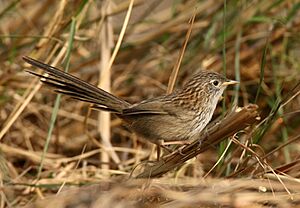Rufous-vented grass babbler facts for kids
Quick facts for kids Rufous-vented grass babbler |
|
|---|---|
 |
|
| Conservation status | |
| Scientific classification | |
| Genus: |
Laticilla
|
| Species: |
burnesii
|
The rufous-vented grass babbler is a small bird found in parts of Pakistan, northwestern India, and Nepal. It's also known as the rufous-vented prinia. This bird belongs to a family called Pellorneidae, which includes many types of babblers.
Contents
About the Name
The rufous-vented grass babbler was first described by an English animal expert named Edward Blyth in 1844. He gave it the scientific name Eurycercus burnesii. The bird was named after Alexander Burnes.
There are two main types, or subspecies, of this bird:
- L. b. burnesii (Blyth, 1844) - This type lives in Pakistan and northwest India.
- L. b. nepalicola Baral, Basnet, Chaudhary, B, Chaudhary, H, Giri & Som, 2008 - This type is found in Nepal.
What It Looks Like
Rufous-vented grass babblers are about 17 cm (6.7 in) long. Their wings measure about 5.3 cm (2.1 in) to 5.9 cm (2.3 in) from the bend to the tip.
Adult birds are a cool brown color on their upper parts. They have a light, buffy area on the back of their neck and upper back, which looks like a collar. Dark stripes start on their forehead and become lighter on their back.
Their belly and chest are whitish with a brownish-orange tint. They also have dark stripes on their sides. The feathers under their tail are a bright reddish-brown color. Their wings have patterns formed by the feathers and their lighter edges. The inside of their wings is a light, off-white color.
The main flight feathers on their wings are grayish-brown. When the wing is folded, these feathers just barely go past the shorter, inner wing feathers. Their tail feathers can be grayish or olive-brown and have reddish-brown tips. The tail is long, measuring 8.7 to 11.5 cm (3.4 to 4.5 in). It gets much shorter towards the outside, meaning the outer feathers are only one-third as long as the middle ones.
The bird's head has a clear white ring around its eye. The area between its eyes and beak is whitish, and its cheeks are whitish with dark stripes.
The top part of its beak is horn-brown, and the bottom part is straw-brown or flesh-brown. Their eyes are brown, with some slight differences in how light or dark they are. Their legs are flesh-colored or pale brown.
From July to September, the bird's feathers can look worn out, especially the tail. The tail might be much shorter than usual and lose its reddish-brown tips. They usually grow new feathers by October.
Young birds, called juveniles, look similar to adults. However, their feathers are looser and fluffier. They have very few or no stripes on their back. Their tail tips are reddish-brown, not brownish-orange. About 4 to 6 weeks after they learn to fly, they grow adult head and body feathers. They keep their flight feathers from when they were young.
Sounds and Song
This bird makes a "wheezy feez" sound. It also makes a quiet, very fast, nasal rattling sound. Its song is described as a warble, which is a soft, flowing sound. It lasts about 4 seconds and is quite loud. Some people compare it to the song of a dunnock, another type of bird.
Where It Lives
This bird is found only in the plains of the Indus River in Pakistan. It also lives in nearby parts of Punjab (India). Sometimes, the swamp grass babbler from Assam and Bangladesh is considered the same species.
The rufous-vented grass babbler lives in many kinds of tall grasslands. This includes plains of sarkhan grass (Saccharum), elephant grass, and ekra grass. Sometimes, these grasses are mixed with acacia trees and tamarisk bushes. It can even live in deserts that have scattered patches of tall grass, and in reedbeds. It prefers to be near large rivers, their smaller streams, or swamps.
How It Behaves
This bird tends to hide low in clumps of grass. It hops and moves through the grass, often in small groups, looking for insects to eat. It usually holds its tail slightly upright. When it flies, which is hard to make it do, it only goes to a nearby grass clump. It is easiest to find this bird during its breeding season. This is when it sings in the mornings and evenings.
Conservation Status
The International Union for Conservation of Nature says the rufous-vented grass babbler is a near threatened species. This means it might become endangered in the future if we don't protect it. It is common in the Punjab and northern Sindh areas. However, it is much rarer in southern Sindh.


